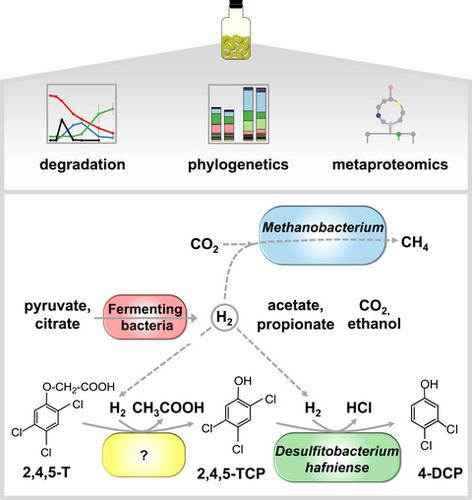当前位置:
X-MOL 学术
›
Microb. Biotechnol.
›
论文详情
Our official English website, www.x-mol.net, welcomes your feedback! (Note: you will need to create a separate account there.)
Desulfitobacterium contributes to the microbial transformation of 2,4,5‐T by methanogenic enrichment cultures from a Vietnamese active landfill
Microbial Biotechnology ( IF 5.7 ) Pub Date : 2018-08-16 , DOI: 10.1111/1751-7915.13301 Ute Lechner 1 , Dominique Türkowsky 2 , Thi Thu Hang Dinh 3 , Hassan Al-Fathi 1 , Stefan Schwoch 1 , Stefan Franke 1 , Michelle-Sophie Gerlach 1 , Mandy Koch 4 , Martin von Bergen 2 , Nico Jehmlich 2 , Thi Cam Ha Dang 3
Microbial Biotechnology ( IF 5.7 ) Pub Date : 2018-08-16 , DOI: 10.1111/1751-7915.13301 Ute Lechner 1 , Dominique Türkowsky 2 , Thi Thu Hang Dinh 3 , Hassan Al-Fathi 1 , Stefan Schwoch 1 , Stefan Franke 1 , Michelle-Sophie Gerlach 1 , Mandy Koch 4 , Martin von Bergen 2 , Nico Jehmlich 2 , Thi Cam Ha Dang 3
Affiliation

|
The herbicide 2,4,5‐trichlorophenoxyacetic acid (2,4,5‐T) was a major component of Agent Orange, which was used as a defoliant in the Vietnam War. Little is known about its degradation under anoxic conditions. Established enrichment cultures using soil from an Agent Orange bioremediation plant in southern Vietnam with pyruvate as potential electron donor and carbon source were shown to degrade 2,4,5‐T via ether cleavage to 2,4,5‐trichlorophenol (2,4,5‐TCP), which was further dechlorinated to 3,4‐dichlorophenol. Pyruvate was initially fermented to hydrogen, acetate and propionate. Hydrogen was then used as the direct electron donor for ether cleavage of 2,4,5‐T and subsequent dechlorination of 2,4,5‐TCP. 16S rRNA gene amplicon sequencing indicated the presence of bacteria and archaea mainly belonging to the Firmicutes, Bacteroidetes, Spirochaetes, Chloroflexi and Euryarchaeota. Desulfitobacterium hafniense was identified as the dechlorinating bacterium. Metaproteomics of the enrichment culture indicated higher protein abundances of 60 protein groups in the presence of 2,4,5‐T. A reductive dehalogenase related to RdhA3 of D. hafniense showed the highest fold change, supporting its function in reductive dehalogenation of 2,4,5‐TCP. Despite an ether‐cleaving enzyme not being detected, the inhibition of ether cleavage but not of dechlorination, by 2‐bromoethane sulphonate, suggested that the two reactions are catalysed by different organisms.
中文翻译:

脱硫杆菌通过越南活跃垃圾填埋场的产甲烷富集培养物促进 2,4,5-T 的微生物转化
除草剂 2,4,5-三氯苯氧基乙酸 (2,4,5-T) 是橙剂的主要成分,在越南战争中被用作脱叶剂。人们对其在缺氧条件下的降解知之甚少。使用越南南部橙剂生物修复工厂的土壤建立的富集培养物,以丙酮酸作为潜在的电子供体和碳源,结果表明,通过乙醚裂解将 2,4,5-T 降解为 2,4,5-三氯苯酚(2,4,5-三氯苯酚)。 5-TCP),进一步脱氯为3,4-二氯苯酚。丙酮酸盐最初发酵成氢气、乙酸盐和丙酸盐。然后使用氢气作为直接电子供体进行 2,4,5-T 的醚裂解以及随后的 2,4,5-TCP 脱氯。16S rRNA基因扩增子测序表明存在细菌和古细菌,主要属于厚壁菌门、拟杆菌门、螺旋体门、绿柔菌门和广古菌门。哈夫尼脱硫杆菌被鉴定为脱氯细菌。富集培养物的宏蛋白质组学表明,在 2,4,5-T 存在的情况下,60 个蛋白质组的蛋白质丰度较高。与D. hafniense的 RdhA3 相关的还原脱卤酶显示出最高的倍数变化,支持其在 2,4,5-TCP 还原脱卤中的功能。尽管没有检测到醚裂解酶,但 2-溴乙磺酸盐抑制醚裂解但不抑制脱氯,表明这两个反应是由不同的生物体催化的。
更新日期:2018-08-16
中文翻译:

脱硫杆菌通过越南活跃垃圾填埋场的产甲烷富集培养物促进 2,4,5-T 的微生物转化
除草剂 2,4,5-三氯苯氧基乙酸 (2,4,5-T) 是橙剂的主要成分,在越南战争中被用作脱叶剂。人们对其在缺氧条件下的降解知之甚少。使用越南南部橙剂生物修复工厂的土壤建立的富集培养物,以丙酮酸作为潜在的电子供体和碳源,结果表明,通过乙醚裂解将 2,4,5-T 降解为 2,4,5-三氯苯酚(2,4,5-三氯苯酚)。 5-TCP),进一步脱氯为3,4-二氯苯酚。丙酮酸盐最初发酵成氢气、乙酸盐和丙酸盐。然后使用氢气作为直接电子供体进行 2,4,5-T 的醚裂解以及随后的 2,4,5-TCP 脱氯。16S rRNA基因扩增子测序表明存在细菌和古细菌,主要属于厚壁菌门、拟杆菌门、螺旋体门、绿柔菌门和广古菌门。哈夫尼脱硫杆菌被鉴定为脱氯细菌。富集培养物的宏蛋白质组学表明,在 2,4,5-T 存在的情况下,60 个蛋白质组的蛋白质丰度较高。与D. hafniense的 RdhA3 相关的还原脱卤酶显示出最高的倍数变化,支持其在 2,4,5-TCP 还原脱卤中的功能。尽管没有检测到醚裂解酶,但 2-溴乙磺酸盐抑制醚裂解但不抑制脱氯,表明这两个反应是由不同的生物体催化的。



























 京公网安备 11010802027423号
京公网安备 11010802027423号